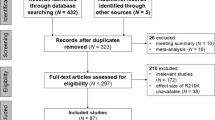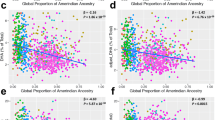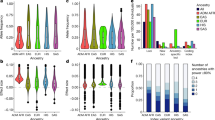Abstract
As a peroxisome proliferator-activated receptor alpha (PPARα) agonist, fenofibrate favorably modulates dyslipidemia and inflammation markers, which are associated with cardiovascular risk. To determine whether variation in the PPARα receptor gene was associated with lipid and inflammatory marker response, we conducted a 3-week trial of fenofibrate in 861 men and women. Mixed linear models that controlled for age and sex, as well as family pedigree and study center, were constructed using single-nucleotide polymorphisms (SNPs) in the PPARα gene as predictors and changes in fasting triglycerides (TGs), cholesterol and inflammatory markers as outcomes. Significant associations with low-density cholesterol and interleukin-2 (P<0.001) responses to fenofibrate were found. Although there were suggestive associations with tumor necrosis factor-alpha and TG responses (P<0.05), these did not survive the correction for multiple testing. We conclude that variants in the PPARα gene may contribute to future pharmacogenomic paradigms seeking to predict fenofibrate responders from both an anti-dyslipidemic and anti-inflammatory perspective.
This is a preview of subscription content, access via your institution
Access options
Subscribe to this journal
Receive 6 print issues and online access
$259.00 per year
only $43.17 per issue
Buy this article
- Purchase on Springer Link
- Instant access to full article PDF
Prices may be subject to local taxes which are calculated during checkout


Similar content being viewed by others
References
Krauss RM . Triglycerides and atherogenic lipoproteins: rationale for lipid management. Am J Med 1998; 105: 58S–62S.
Wilson PW, Garrison RJ, Castelli WP, Feinleib M, McNamara PM, Kannel WB . Prevalence of coronary heart disease in the Framingham Offspring Study: role of lipoprotein cholesterols. Am J Cardiol 1980; 46: 649–654.
Ballantyne CM, Nambi V . Markers of inflammation and their clinical significance. Atheroscler Suppl 2005; 6: 21–29.
Cesari M, Penninx BW, Newman AB, Newman AB, Kritchevsky SB, Nicklas BJ et al. Inflammatory markers and onset of cardiovascular events: results from the Health ABC study. Circulation 2003; 108: 2317–2322.
Cullen P . Evidence that triglycerides are an independent coronary heart disease risk factor. Am J Cardiol 2000; 86: 943–949.
Hausenloy DJ, Yellon DM . Targeting residual cardiovascular risk: raising high-density lipoprotein cholesterol levels. Postgrad Med J 2008; 84: 590–598.
Knopp RH, Walden CE, Warnick GR, Albers JJ, Ginsberg J, McGinnis BM . Effect of fenofibrate treatment on plasma lipoprotein lipids, high-density lipoprotein cholesterol subfractions, and apolipoproteins B, AI, AII, and E. Am J Med 1987; 83: 75–84.
Sebestjen M, Keber I, Zegura B, Simcic S, Bozic M, Fressart MM et al. Statin and fibrate treatment of combined hyperlipidemia: the effects on some novel risk factors. Thromb Haemost 2004; 92: 1129–1135.
Rosenson RS . Effect of fenofibrate on adiponectin and inflammatory biomarkers in metabolic syndrome patients. Obesity 2009; 17: 504–509.
Rosenson RS, Huskin AL, Wolff DA, Helenowski IB, Rademaker AW . Fenofibrate reduces fasting and postprandial inflammatory responses among hypertriglyceridemia patients with the metabolic syndrome. Atherosclerosis 2008; 198: 381–388.
Jonkers IJ, Mohrschladt MF, Westendorp RG, van der Laarse A, Smelt AH . Severe hypertriglyceridemia with insulin resistance is associated with systemic inflammation: reversal with bezafibrate therapy in a randomized controlled trial. Am J Med 2002; 112: 275–280.
Okopien B, Krysiak R, Kowalski J, Madej A, Belowski D, Zieliñski M et al. The effect of statins and fibrates on interferon-gamma and interleukin-2 release in patients with primary type II dyslipidemia. Atherosclerosis 2004; 176: 327–335.
Keating GM, Ormrod D . Micronised fenofibrate: an updated review of its clinical efficacy in the management of dyslipidaemia. Drugs 2002; 62: 1909–1944.
Ordovas JM . Pharmacogenetics of lipid diseases. Hum Genomics 2004; 1: 111–125.
Smith JA, Arnett DK, Kelly RJ, Ordovas JM, Sun YV, Hopkins PN et al. The genetic architecture of fasting plasma triglyceride response to fenofibrate treatment. Eur J Hum Genet 2008; 16: 603–613.
Liu Y, Ordovas JM, Gao G, Province M, Straka RJ, Tsai MY et al. Pharmacogenetic association of the APOA1/C3/A4/A5 gene cluster and lipid responses to fenofibrate: the genetics of lipid-lowering drugs and diet network study. Pharmacogenet Genomics 2009; 19: 161–169.
Shen J, Arnett DK, Parnell LD, Peacock JM, Lai CQ, Hixson JE et al. Association of common C-reactive protein (CRP) gene polymorphisms with baseline plasma CRP levels and fenofibrate response: the GOLDN study. Diabetes Care 2008; 31: 910–915.
Mandard S, Muller M, Kersten S . Peroxisome proliferator-activated receptor alpha target genes. Cell Mol Life Sci 2004; 61: 393–416.
Spinelli SL, O'Brien JJ, Bancos S, Lehmann GM, Springer DL, Blumberg N et al. The PPAR-platelet connection: modulators of inflammation and potential cardiovascular effects. PPAR Res 2008; 2008: 328172.
Rizzo G, Fiorucci S . PPARs and other nuclear receptors in inflammation. Curr Opin Pharmacol 2006; 6: 421–427.
Pankow JS, Province MA, Hunt SC, Arnett DK . Regarding “Testing for population subdivision and association in four case-control studies”. Am J Hum Genet 2002; 71: 1478–1480.
Patsch JR, Miesenböck G, Hopferwieser T, Mühlberger V, Knapp E, Dunn JK et al. Relation of triglyceride metabolism and coronary artery disease. Studies in the postprandial state. Arterioscler Thromb Vasc Biol Am Heart Assoc 1992; 12: 1336–1345.
Liu Y, Ordovas JM, Gao G, Province M, Straka RJ, Tsai MY et al. The SCARB1 gene is associated with lipid response to dietary and pharmacological interventions. J Hum Genet 2008; 53: 709–717.
Straka RJ, Burkhardt RT, Fisher JE . Determination of fenofibric acid concentrations by HPLC after anion exchange solid-phase extraction from human serum. Ther Drug Monit 2007; 29: 197–202.
Benjamini Y, Hochberg Y . Controlling the false discovery rate: a practical and powerful approach to multiple testing. J R Stat Soc Ser B 1995; 57: 289–300.
Barrett JC, Fry B, Maller J, Daly MJ . Haploview: analysis and visualization of LD and haplotype maps. Bioinformatics 2005; 21: 263–265.
Horvath S, Xu X, Lake SL, Silverman EK, Weiss ST, Laird NM . Family-based tests for associating haplotypes with general phenotype data: application to asthma genetics. Genet Epidemiol 2004; 26: 61–69.
Caslake MJ, Packard CJ, Gaw A, Murray E, Griffin BA, Vallance BD et al. Fenofibrate and LDL metabolic heterogeneity in hypercholesterolemia. Arterioscler Thromb 1993; 13: 702–711.
Kraja AT, Province MA, Straka RJ, Ordovas JM, Borecki IB, Arnett DK . Fenofibrate and metabolic syndrome. Endocr Metab Immune Disord Drug Targets 2010; 10: 138–148.
Reinhard W, Stark K, Sedlacek K, Fischer M, Baessler A, Neureuther K et al. Association between PPARalpha gene polymorphisms and myocardial infarction. Clin Sci 2008; 115: 301–308.
Brisson D, Ledoux K, Bosse Y, St-Pierre J, Julien P, Perron P et al. Effect of apolipoprotein E, peroxisome proliferator-activated receptor alpha and lipoprotein lipase gene mutations on the ability of fenofibrate to improve lipid profiles and reach clinical guideline targets among hypertriglyceridemic patients. Pharmacogenetics 2002; 12: 313–320.
Foucher C, Rattier S, Flavell DM, Talmud PJ, Humphries SE, Kastelein JJ et al. Response to micronized fenofibrate treatment is associated with the peroxisome-proliferator-activated receptors alpha G/C intron7 polymorphism in subjects with type 2 diabetes. Pharmacogenetics 2004; 14: 823–829.
Jun M, Foote C, Lv J, Neal B, Patel A, Nicholls SJ et al. Effects of fibrates on cardiovascular outcomes: a systematic review and meta-analysis. Lancet 2010; 375: 1875–1884.
Enquobahrie DA, Smith NL, Bis JC, Carty CL, Rice KM, Lumley T et al. Cholesterol ester transfer protein, interleukin-8, peroxisome proliferator activator receptor alpha, and Toll-like receptor 4 genetic variations and risk of incident nonfatal myocardial infarction and ischemic stroke. Am J Cardiol 2008; 101: 1683–1688.
Shin T, Kuboki S, Huber N, Eismann T, Galloway E, Schuster R et al. Activation of peroxisome proliferator-activated receptor-gamma during hepatic ischemia is age-dependent. J Surg Res 2008; 147: 200–205.
Belfort R, Berria R, Cornell J, Cusi K . Fenofibrate reduces systemic inflammation markers independent of its effects on lipid and glucose metabolism in patients with the metabolic syndrome. J Clin Endocrinol Metab 2010; 95: 829–836.
Kon KK, Yeal AJ, Hwan HS, Kyu Jin D, Sik Kim H, Cheon Lee K et al. Effects of fenofibrate on lipoproteins, vasomotor function, and serological markers of inflammation, plaque stabilization, and hemostasis. Atherosclerosis 2004; 174: 379–383.
Okopien B, Krysiak R, Herman ZS . Effects of short-term fenofibrate treatment on circulating markers of inflammation and hemostasis in patients with impaired glucose tolerance. J Clin Endocrinol Metab 2006; 91: 1770–1778.
Delerive P, Fruchart JC, Staels B . Peroxisome proliferator-activated receptors in inflammation control. J Endocrinol 2001; 169: 453–459.
Guay DR . Micronized fenofibrate: a new fibric acid hypolipidemic agent. Ann Pharmacother 1999; 33: 1083–1103.
Michie S, Bobrow M, Marteau TM . Predictive genetic testing in children and adults: a study of emotional impact. J Med Genet 2001; 38: 519–526.
Acknowledgements
We are grateful to the staff of the GOLDN study for the assistance in data collection and management. This study was funded by National Heart, Lung and Blood Institute grant number U01HL072524.
Author information
Authors and Affiliations
Corresponding author
Ethics declarations
Competing interests
The authors declare no conflict of interest.
Additional information
Supplementary Information accompanies the paper on the The Pharmacogenomics Journal website
Supplementary information
PowerPoint slides
Rights and permissions
About this article
Cite this article
Frazier-Wood, A., Ordovas, J., Straka, R. et al. The PPAR alpha gene is associated with triglyceride, low-density cholesterol and inflammation marker response to fenofibrate intervention: the GOLDN study. Pharmacogenomics J 13, 312–317 (2013). https://doi.org/10.1038/tpj.2012.9
Received:
Revised:
Accepted:
Published:
Issue Date:
DOI: https://doi.org/10.1038/tpj.2012.9
Keywords
This article is cited by
-
Bilirubin as an indicator of cardiometabolic health: a cross-sectional analysis in the UK Biobank
Cardiovascular Diabetology (2022)
-
Pharmacogenetics of Lipid-Lowering Agents: Precision or Indecision Medicine?
Current Atherosclerosis Reports (2016)
-
Pharmacogenomics, Lipid Disorders, and Treatment Options
Clinical Pharmacology & Therapeutics (2014)



